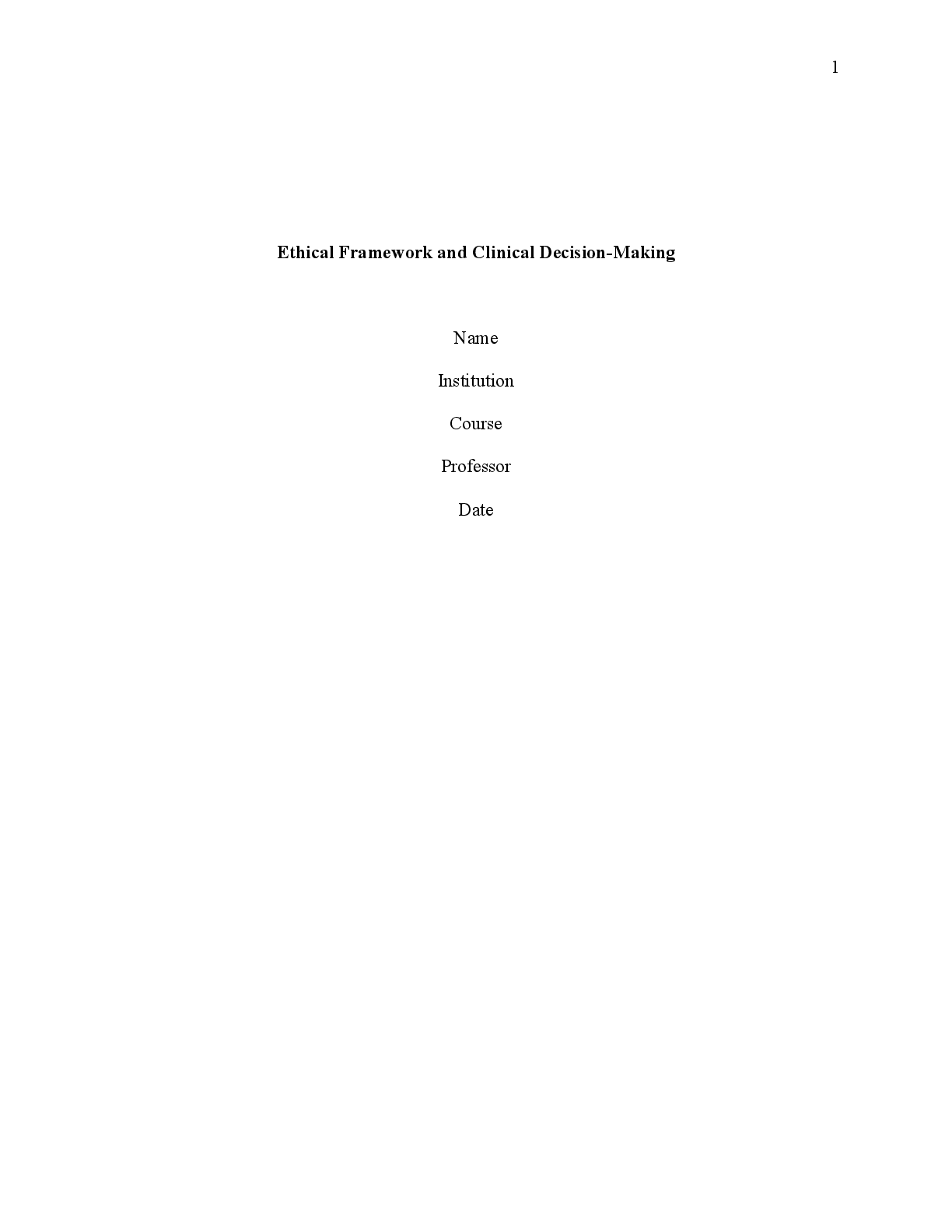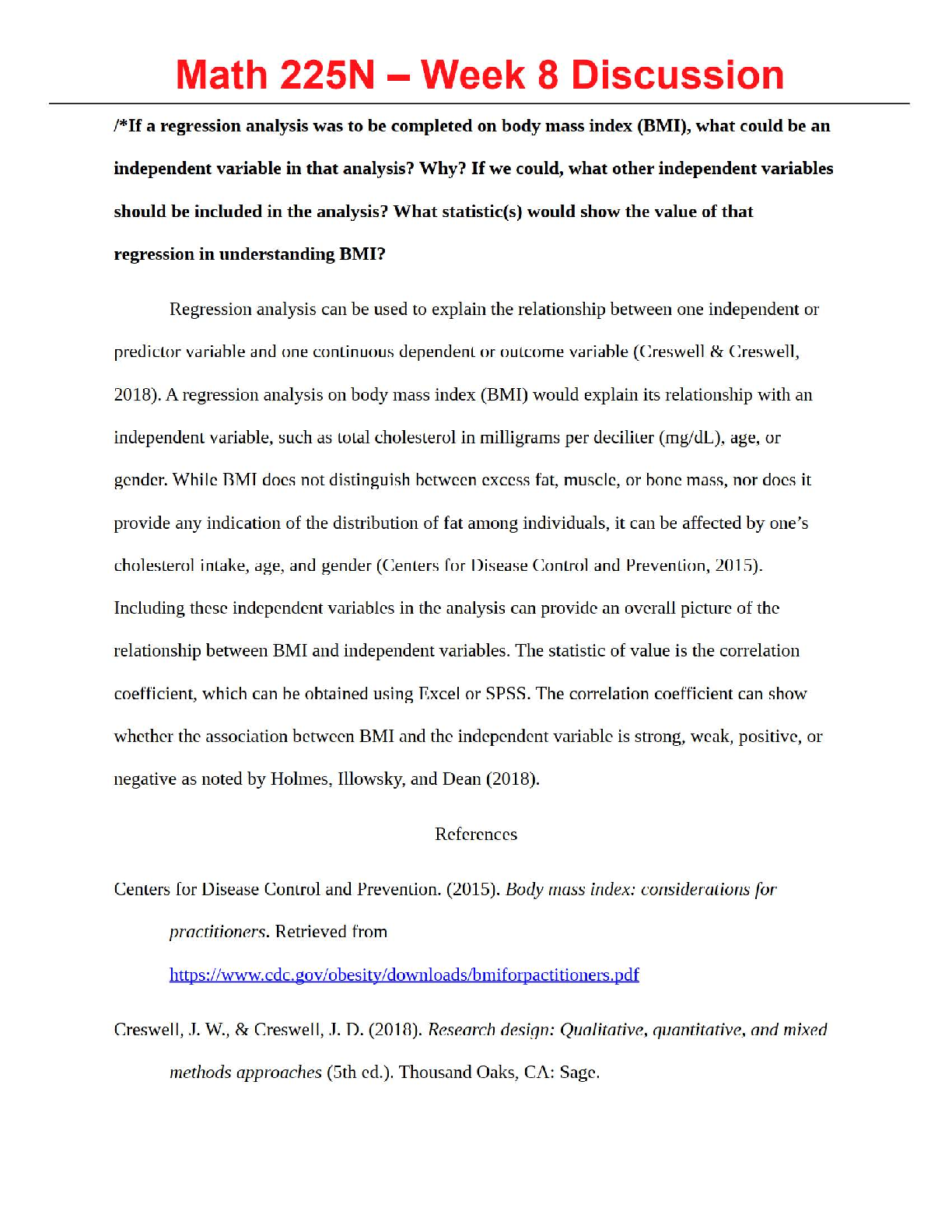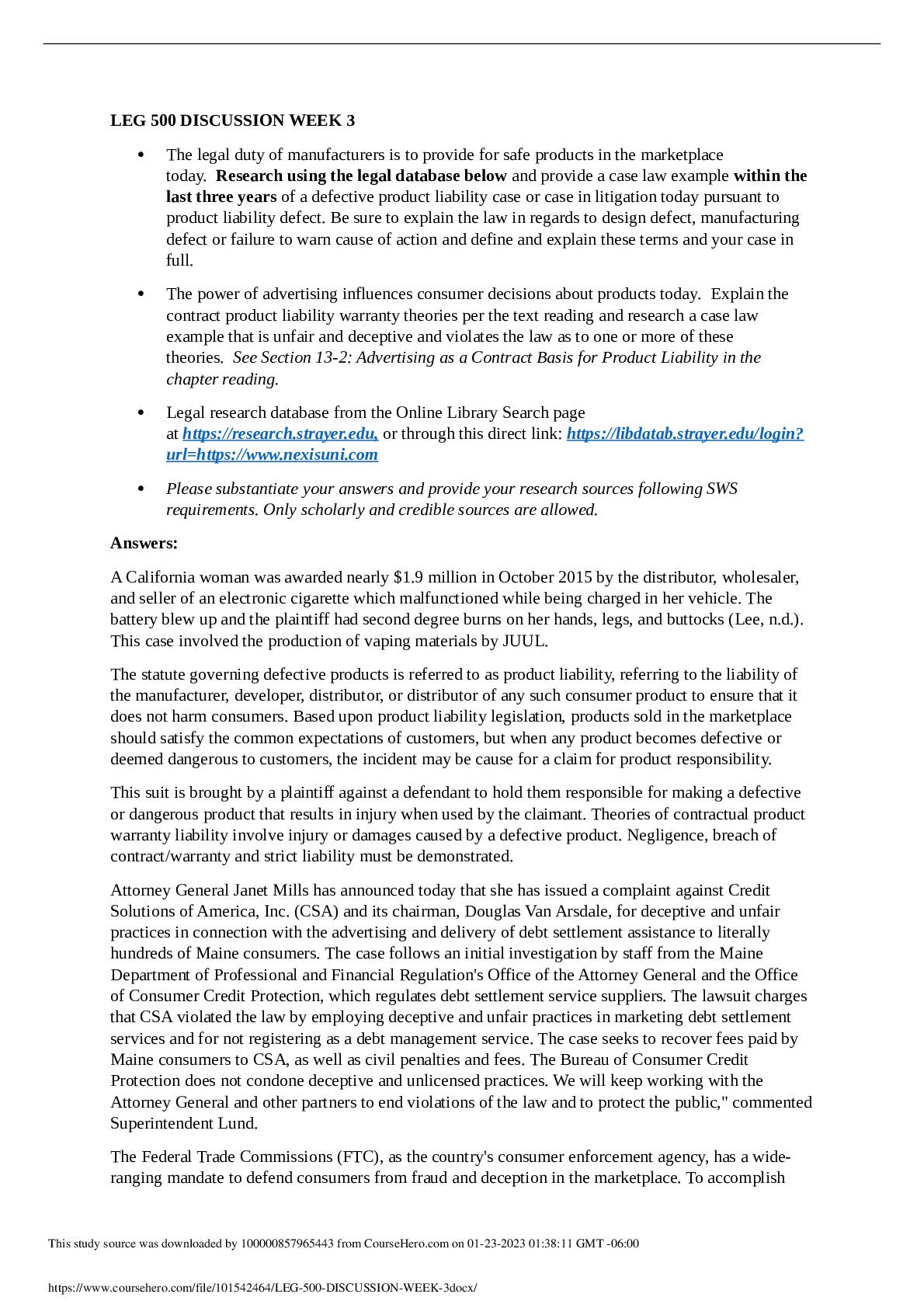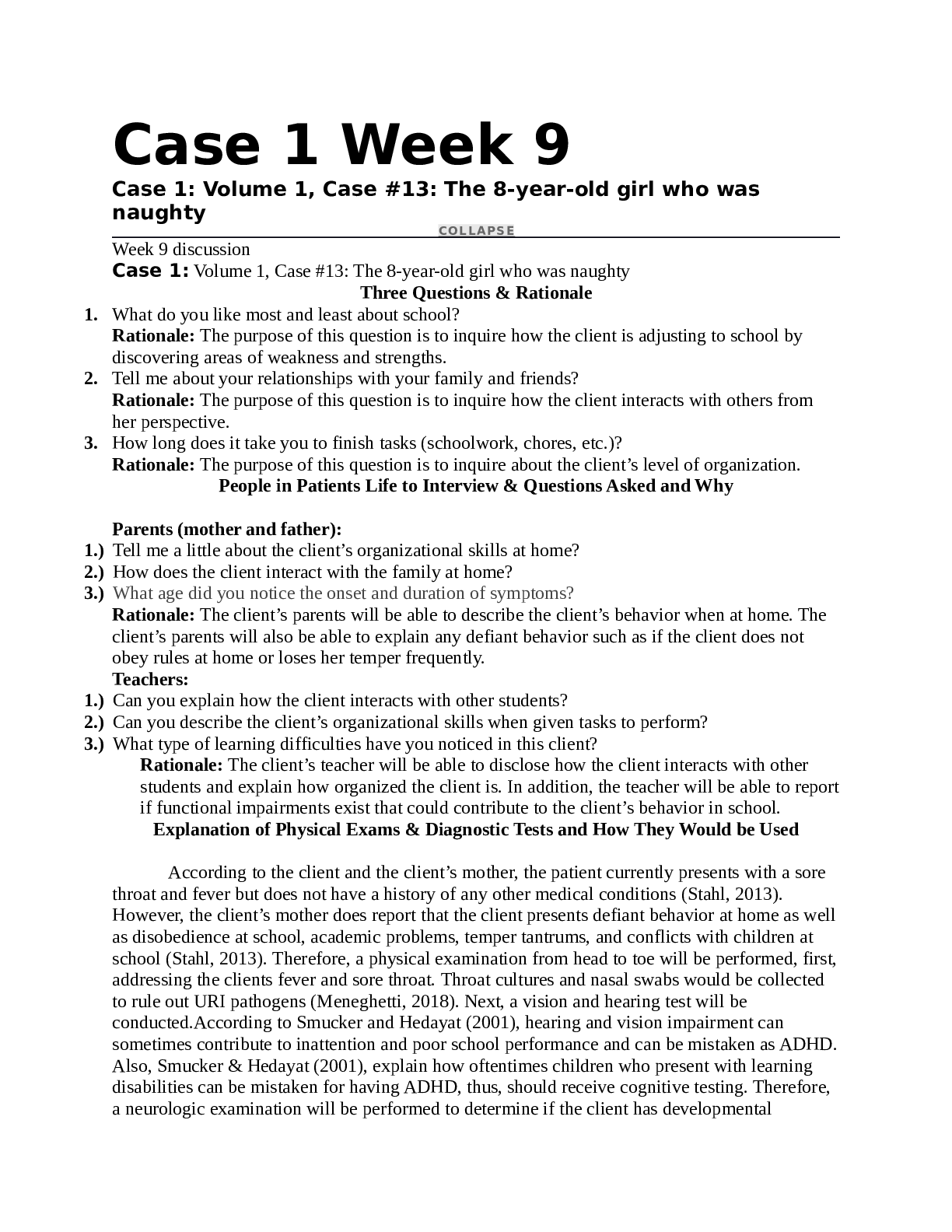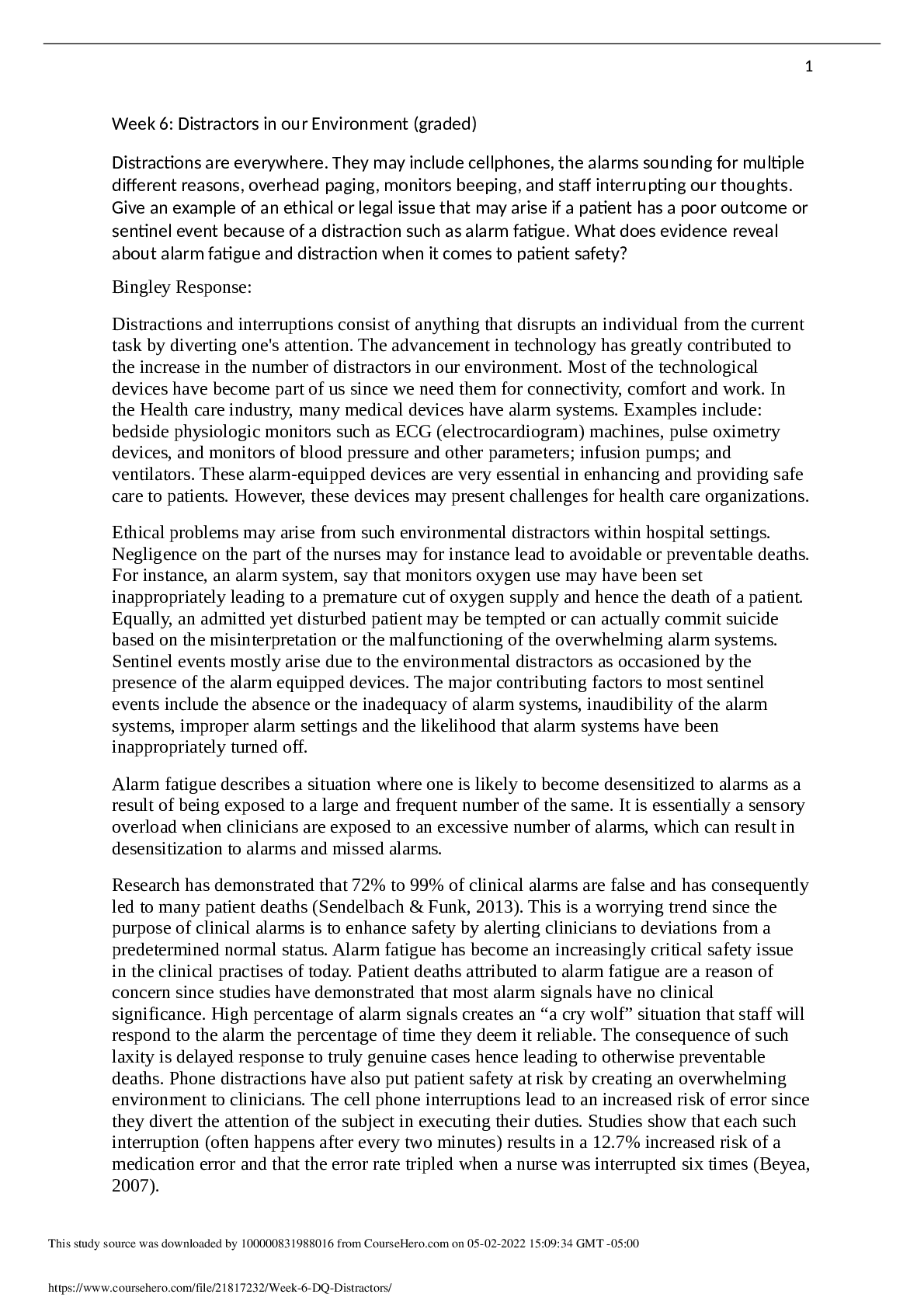*NURSING > DISCUSSION POST > NUTRITION DISCUSSION BOARD 2021 (All)
NUTRITION DISCUSSION BOARD 2021
Document Content and Description Below
Part 1 Explain the components of a nutritional assessment. What important subjective and objective assessment findings will assist the nurse in developing a nutritional plan? Use evidence from one s ... cholarly source other than your textbook or ATI book to support your answer. Use APA Style to cite your source. Part 2 Discuss the normal metabolism of macronutrients in the body (CHO, PRO, and FAT). Choose one of the disorders below and discuss how the metabolism of each macronutrient (CHO, PRO, and FAT) is altered. Use evidence from one scholarly source other than your textbook or ATI book to support your answer. Use APA Style to cite your source. • Irritable Bowel Syndrome • Liver disease • Diabetes • Phenylketonuria My Answer Part 1 There are 5 aspects of a nutritional assessment: 1. Anthropometric Assessment 2. Biochemical Assessment 3. Clinical Assessment 4. Dietary Assessment 5. Environmental Factors These are all included in a nutritional assessment. Anthropometric is objective data that focuses on the physical aspects of the human anatomy. Such as: current weight and weight changes, body mass index (BMI), or mid upper arm circumference. This data is important because weight affects the amount of effort that is place upon the heart and other vital organs. The Biochemical Assessment is objective data that is obtained through blood tests. It examines hemoglobin levels including glycated hemoglobin HbA1c which is used to identify the average range of a person’s blood sugar over an extended period of time. This test also examines for micronutrients, sodium, calcium and phosphate along with several other chemicals within the blood. They examine these to check the functionality of vital organs like the liver, and kidneys. The Clinical Assessment is also a collection of objective data. This is the information that the medical professionals gain from their examination of a patient’s heart, lungs, brain, GI tract, and anything else that might be affected. This is an important assessment to do because it establishes a baseline. Diseases can influence a person’s nutritional state and can cause them to not receive the proper nutrition. Dietary Assessments are a collection of subjective data. With this assessment the nurse is looking for how much energy a patient has had, or their hydration or fluid status on a regular basis. They also ask the patient what they typically eat throughout a regular day and what they recall eating within the past 24 hours. The Environmental factors are both subjective and objective data. This includes assessing a patient’s ability to eat or consume food. Dentures, dysphagia, food intolerance, diarrhea or vomiting. The social factors involving meal times and food such as: budget constraints, meal timings, family support, mobility issues ability to shop and or to cook. All of these things affect a patient’s nutrition and can cause them to suffer from malnutrition. All of these are vital parts of a nutritional assessment and if a patient is lacking in one area it can lead to malnutrition and other health issues. Home. (n.d.). Retrieved from https://www.bapen.org.uk/nutrition-support/assessment-and- planning/nutritional-assessment?showall=1%5C Week 1 Part 2 Discuss the normal metabolism of macronutrients in the body (CHO, PRO, and FAT). Choose one of the disorders below and discuss how the metabolism of each macronutrient (CHO, PRO, and FAT) is altered. Use evidence from one scholarly source other than your textbook or ATI book to support your answer. Use APA Style to cite your source. • Irritable Bowel Syndrome • Liver disease • Diabetes • Phenylketonuria My Answer Part 2 Energy is what allows the body to function, without it life ceases to exist. The human body receives and creates energy by the foods that are consumed. However, the different types of food are broken down and utilized in different ways. The biggest sources of energy for the body come from macronutrients, specifically: Carbohydrates, Proteins, and Fats Carbohydrates is a string of carbon atoms that are surrounded by oxygen and hydrogen atoms. Carbohydrates are quickly turned into energy through the process of cellular respiration. However, because of the difference between complex carbohydrates and simple carbohydrates they are not all equal. Simple carbs are easy to turn into glucose and take very little time. Complex Carbs take a lot more work and effort and some cannot be broken down at all this is fiber. There are two types of fiber, insoluble and soluble. Insoluble passes through the digestive tract without collecting and biproducts. Soluble fiber collects waste throughout the blood stream and leads it out. Proteins are a long string of amino acids tied together by peptide bonds. Proteins are the main source of amino acids which are the building blocks of the cells and tissues. While some amino acids are made in the body, complete proteins which come from animal products supply nine specific essential ones. The breakdown of proteins occurs primarily within the stomach because the hydrochloric acid is strong enough to break the peptide bonds. Once the bond is broken the amino acids are freed and absorbed into the blood stream and carried through the body. Fats are strings of fatty acids which can be broken by the enzyme lipase which is produced by the pancreas. Fats can be either saturated or unsaturated. Unsaturated fat is also known as good fat and can help keep cholesterol low when taken in moderation. This can be broken down into two categories monounsaturated and polyunsaturated fats. Saturated fats are more likely to cause health issues because they raise cholesterol and are not soluble and clog the arteries. Liver Disease Carbohydrate Metabolism Liver cells called hepatocytes are responsible for many things including assisting in the maintenance of blood glucose levels. When excess glucose occurs in the body it is taken up by the liver and transformed via glycogenesis to save for later. When the body needs more glucose then the liver is responsible for glycogenolysis which transports glucose back into the blood stream. The liver is also responsible for gluconeogenesis which is when they create glucose out of amino acids and other products because the glucose store was depleted. If the liver is no longer able to function than glucose will remain in the blood stream causing hyperglycemia and can lead to more serious issues. Protein Metabolism The liver plays a critical role in protein metabolism. It is involved in converting amino acids into glucose or lipids. When there is damage to the liver the enzymes used in this process are examined to assess for the damage. The liver is also responsible for removing the ammonia that occurs with protein synthesis. When ammonia is not removed it can cause damage to the central nervous system. Fat Metabolism The liver is active in metabolizing fats, and one of the ways that it does this is by oxidizing triglycerides as a way to produce energy. The liver breaks down large amounts of fatty acids to allow other cells to pick up the acetoacetate and deliver it to other tissues. The liver synthesizes most lipoproteins and is a major location for conversion of carbs and proteins into fatty acids and triglyceride to be stored. Without the liver there is a shortage of acetoacetate throughout the body because the liver supports so many organs and tissues. Week 2 Part 1 Discuss the different types of micronutrients and their function in the body. Choose two micronutrients and discuss the signs and symptoms of toxicity and deficiency for each nutrient. What disease process would cause toxicity and deficiencies for both nutrients? Use evidence from one scholarly source other than your textbook or ATI book to support your answer. Use APA Style to cite your source. Part 2 Tonya is 5' 3" tall, weighs 151 pounds, and is 38 years old. Her waist circumference is 37". Her life is busy but sedentary. She simply does not have the time or energy to stay with an exercise program after working all day as a receptionist and caring for her two socially active children. She would like to lose about 20 pounds but knows dieting doesn’t work for her— all the diets she has tried in the past have left her hungry and feeling deprived. Losing weight has taken on greater importance since her doctor told her that both her blood pressure and glucose levels are at “borderline” high levels. • What is her BMI? (show actual calculation) • According to her BMI, activity level, and lifestyle, what health disparities is Tonya at risk for? • Develop an evidence-based educational plan to help Tonya meet her 20 lb. weight loss goal. Consider her activity and lifestyle. My Answer Part 1 Vitamins and Minerals are a vital aspect of what nourishes our bodies. They provide assistance throughout the body performing various tasks. Vitamins which are either water or fat soluble have numerous roles such as: aiding in the metabolism of macronutrients, developing genetic material and red blood cells, releasing energy from carbohydrates and formation of hair and skin cells. Minerals are also vital aspects and help to perform a variety of tasks as well. Such as: maintaining bone structure and mass, fluid balance, iron absorption, oxygen transport, break- down of amino acids and DNA synthesis. One of the major minerals in the body is Magnesium. Magnesium helps to maintain a healthy metabolism as well as muscles, nerves, bones and the heart. The normal amount that is required by the body is 400-420 milligrams for males and 310-320 milligrams for females. According to (Schaefer) Hypermagnesemia is a rare occurrence because the kidneys generally expel the excess magnesium. If the kidneys are damaged or failing this does not occur thus causing elevation of magnesium in the blood and creating a toxic level. If hypermagnesemia does occur than it can affect numerous bodily functions especially with the heart. Such as creating an irregular heartbeat, low blood pressure and even cardiac arrest. It can also effect breathing and the GI tract among other things. Hypomagnesemia occurs when there is not enough magnesium in the body. When this happens there are specific signs that can be seen such as Chvotek and Trousseu signs along with convulsions. This occurs because magnesium affects nerve function so without enough of it the nerves are not able to properly send or receive signals. One of the major vitamins that we need is folate which is a water-soluble vitamin. This vitamin is found mainly in organ meats and green leafy vegetables. This is an important vitamin because it assists in the development of genetic material and red blood cell production. This vitamin is especially important during fetal development; however, too much can be very damaging. Too much can lead to irreversible neurological damage and hide vitamin B12 deficiencies. According to Hopkins Medicine not enough folate can lead to anemia called folate-deficiency anemia. Because folate helps with the production of red blood cells a lack of this vitamin can lead to this form of anemia. Folate-Deficiency Anemia. (n.d.). Retrieved from https://www.hopkinsmedicine.org/health/conditions-and-diseases/folate-deficiency-anemia Schaefer, A. (1978, July 04). Magnesium Overdose: What's the Likelihood? Retrieved from Week 2 Part 2 Tonya is 5' 3" tall, weighs 151 pounds, and is 38 years old. Her waist circumference is 37". Her life is busy but sedentary. She simply does not have the time or energy to stay with an exercise program after working all day as a receptionist and caring for her two socially active children. She would like to lose about 20 pounds but knows dieting doesn’t work for her— all the diets she has tried in the past have left her hungry and feeling deprived. Losing weight has taken on greater importance since her doctor told her that both her blood pressure and glucose levels are at “borderline” high levels. • What is her BMI? (show actual calculation) • According to her BMI, activity level, and lifestyle, what health disparities is Tonya at risk for? • Develop an evidence-based educational plan to help Tonya meet her 20 lb. weight loss goal. Consider her activity and lifestyle. My Answer What is her BMI? BMI can be calculated by dividing a patient’s weight in kilograms by their height in meters squared. According to the CDC “If your BMI is 25.0 to <30, it falls within the overweight range.” To discover Tonya’s BMI her weight and height have to be converted. To convert pounds to kilograms you must divide the weight in pounds by 2.2 kilograms, so it is 151 divided by 2.2 which gives us 68.6 kg. To convert feet to meters we must divide the patient’s height in feet by 3.28 in order to convert it to meters, so it is 5.3 divided by 3.28 which gives us 1.6 meters. In kilograms her weight is 68.6 kg and her height is 1.6 meters divide her weight by her height in meters squared which equals BMI 26.7 this indicates that Tonya is overweight for someone of her stature. According to her BMI, activity level, and lifestyle, what health disparities is Tonya at risk for? Because of Tonya’s overweight status and sedentary lifestyle she is at an increased risk of becoming obese if she does not alter her current way of living. She is also at an increased risk of morbidity and mortality related to: coronary heart disease, hypertension, hypercholesterolemia, and type 2 diabetes. Develop an evidence-based educational plan to help Tonya meet her 20 lb. weight loss goal. Consider her activity and lifestyle. Tonya should be educated on clean eating and how it does not necessarily involve dieting but more of a conscious decision to eat healthier foods. The nurse can educate her on healthy fats and carbohydrates and how to include them into her and her family’s meal plans. She can also try eating five or six smaller meals throughout the day instead of three huge ones. She should be informed on healthy snacks like oatmeal bars, legumes and citrus fruits to help her feel fuller throughout the day. The nurse can also inform her that clean eating can provide her with more energy throughout the day and might allow her to feel energized for some physical activity. However, she can also start of with smaller ways to increase her daily activity. She can take the stairs at her office, if her office is not too far, she could even walk to work some mornings. Week 3 Part 1 Locate an article on the nutritional beliefs of a culture or religion. Provide a summary of the article and include a link to the article. What interventions should be implemented to ensure cultural competence? Use evidence from one scholarly source other than your textbook or ATI book to support your answer. Use APA Style to cite your source Part 2 My Answer Part 1 Food habits and what drives and creates them is a complex aspect of human behavior. What creates these habits derives from a few different facets of a person’s life. How someone experiences and accepts food is influenced by biochemical, phycological, social and educational stand points. These are all what originates a person’s diet however other factors and conditions alter and change how nutrition is experienced and used. Medical conditions and allergies effect what someone can and cannot eat. Age, gender and mental status can change how food is perceived, tastes and even looks and smells. Throughout all of this one of the biggest origins of a person’s nutritional tastes derives from their culture. A person’s culture is made up of their values, attitudes, habits and customs that they learn throughout their lives. The article that I have chosen to discuss covers the dietary requirements or restrictions for multiple different religions. Such as Islam, Hinduism, Sikhism and Judaism. It also goes into details about the different types of diets observed by other groups or religions but not as in great detail. This article explains fasting in regards to Muslim women and the vegetarian guidelines for other religions. Overall, this article by Sara Patience, is very thorough in the explanation of each region. One religion in particular that this article focused on was Judaism and the kosher requirements that the followers of this faith and culture abide by. It states that the food must be suitable and pure but it does not necessarily restrict any food types just some elements. While they are not vegetarians, they do have requirements on their meet such as “After slaughter, forbidden blood, veins and certain fats must be removed” (Patience et al.). They also state that meat and dairy cannot be consumed together and a period of time must pass before it is acceptable. These patients also need to wash their hands before eating as a sign of cleanliness. For burials these patients do not generally allow autopsies unless highly unusual circumstances occur. In order to truly make sure you can abide by religious beliefs and cultures you can identify what it is and do research to make sure you are being respectful. Part 2 Discuss the difference between food borne illness and food poisoning. Provide an example of each and discuss the mode of transmission, signs and symptoms, treatment, and prognosis. What education would the nurse provide on prevention? Use evidence from one scholarly source other than your textbook or ATI book to support your answer. Use APA Style to cite your source My Answer Food poisoning occurs as a result of toxins that are on the food that we consume. The toxins could result from improperly handled food, chemically treated food, or food that was not stored properly and is no longer good. Symptoms for this is a wide variety ranging from nausea and vomiting to diarrhea. Food bourne illnesses can be derived from a variety of sources such as: 1. Undercooked Meat resulting in Toxoplasmosis: a. A parasitic infection which can cause congenital birth defects, such as mental retardation, blindness, and epilepsy. b. Signs and Symptoms of this are body aches, swollen lymph nodes, headaches and fevers 2. Raw fish and any Shark, Sword Fish or Tilefish resulting in Mercury Poisoning: a. Methylmercury is a dangerous neurotoxin that can inhibit fetal brain development. b. Signs and Symptoms of this are: weakness muscle atrophy and twitching. 3. Unpasteurized dairy products which leads to Listeria monocytogenes: a. A food-borne bacterial infection that can cause miscarriage, stillbirth, premature birth, or neonatal meningitis b. Sign and Symptoms of this are: headache, stiff neck, loss of balance and potential convulsions [Show More]
Last updated: 3 years ago
Preview 1 out of 18 pages
Buy this document to get the full access instantly
Instant Download Access after purchase
Buy NowInstant download
We Accept:

Reviews( 0 )
$6.50
Can't find what you want? Try our AI powered Search
Document information
Connected school, study & course
About the document
Uploaded On
Aug 07, 2021
Number of pages
18
Written in
All
Additional information
This document has been written for:
Uploaded
Aug 07, 2021
Downloads
0
Views
73



